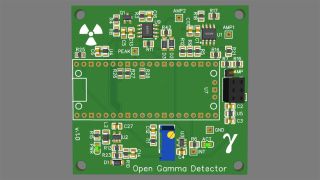Raspberry Pi Pico Detects Gamma Rays in Open Spectroscopy Project
Click, click, click, clickclickclickclickclick...

There are many useful things you can do with a Raspberry Pi Pico, as our listing of the best Raspberry Pi Projects underlines. However, here’s one we admit we’d never thought of: detecting radiation. Physicist Matthias Rosezky, AKA Nuclear Phoenix, whose work has also been covered by Hackaday, has written up a detailed account of building a DIY gamma-ray spectrometer in IEEE Spectrum.


The device acts a little like a Geiger counter but is more sensitive and can identify the exact combination of isotopes that makes the detector click. Rosezky described the Pico as the ‘natural choice’ for a microcontroller when creating this project. He purchased a small sodium iodine crystal from eBay for $40 and combined it with a silicon photomultiplier. All this was connected to a carrier board, into which the Pi Pico was inserted. A gamma ray produces an electron with proportional energy in the crystal, which excites the atoms as it moves through the structure. This causes photons - light - to be emitted, and by counting the photons, you can know the energy of the gamma ray.
Known as the Open Gamma Detector, the aim behind the project is to keep the price down, as the devices can cost over $1,000 if purchased from a lab supplier. Measuring just 6cm x 6cm (2.3in square), the custom detector PCB makes up most of the device’s area, as the Pico itself slots into it.
The photons that come out of the crystal are amplified and measured by a photomultiplier, which releases a voltage. This is then increased to a detectable level using a non-inverting operational amplifier, which is picked up by a peak detector and pulse discriminator connected to the microcontroller. Any detections are sent to a recording voice over USB and can also make an audible CLICK sound as a warning. No external sound hardware is required.
Programming comes via the Arduino IDE. Rosezky wrote his own library to calibrate the detector, and all code, as well as specifications for the carrier board, are available on GitHub, including a sample web app that plots spectra.
One notable issue with the Pico is a differential non-linearity error, speculated to be something to do with the board’s capacitors, that leads to four (out of 4,096) input channels being much more sensitive than the rest. Rosezky utilizes the simple solution of discarding the signals from these channels so as not to have spikes that skew the readings and hopes it will get fixed in hardware soon.
Stay on the Cutting Edge
Join the experts who read Tom's Hardware for the inside track on enthusiast PC tech news — and have for over 25 years. We'll send breaking news and in-depth reviews of CPUs, GPUs, AI, maker hardware and more straight to your inbox.

Ian Evenden is a UK-based news writer for Tom’s Hardware US. He’ll write about anything, but stories about Raspberry Pi and DIY robots seem to find their way to him.
Most Popular

